Graphics Reference
In-Depth Information
1.0
0.8
0.6
0.4
0.2
0.
400
500
Wavelength (nm)
600
700
Figure 28.6: The luminous efficiency at each wavelength tells how much less bright light of
that wavelength appears than light at the standard wavelength of 555 nm.
provoking a response than light at wavelength 555 nm. Scaling so that the largest
value of
g
(
)
(see Fig-
ure 28.6); the resultant graph shows the
luminous efficiency function
for the
human eye. (“Efficiency” here refers to how efficient energy at a particular wave-
length is in provoking the sensation of brightness.)
The luminous efficiency graph actually varies from person to person, and
varies based on the person's age as well; in view of this, a standard luminous
efficiency curve was derived by averaging many observations.
This standardized tabulation can be used to define the
luminance
of a
light source: We multiply the intensity at each of the tabulated wavelengths by
the luminous efficiency value for that wavelength, and compute the sum, thus
approximating the value
λ
)
is 100%, we can plot the resultant function
λ →
e
(
λ
I
(
λ
)
e
(
λ
)
d
λ
,
(28.3)
where
I
(
. The resultant value has units
of
candelas,
which is the SI unit for the measurement of
luminous intensity.
One candela is the luminous intensity, in a given direction, of a source that emits
monochromatic radiation at a frequency of 540
λ
)
is the spectral intensity at wavelength
λ
10
12
Hz (i.e., 555 nm wave-
length),
1
and whose radiant intensity in that direction is 1
×
683 watt per steradian.
The international standards committee chose the peculiar numbers in this def-
inition to make it closely match earlier measures that were based on the light
from a single standard candle, or the light from a certain near-blackbody source
(a square centimeter of melting platinum). Naturally, light at other wavelengths,
of equal radiant intensity, produces fewer candelas of visible light than does light
at 555 nm.
To give a sense of common illumination in terms of candelas, my LCD screen
emits about 250 candelas per square meter (one candela per square meter is called
a
nit;
it's the photometric term corresponding to radiance in radiometry), while
the light from the screen at a movie theatre is about 40 candelas per square meter.
/
1. The definition is given in terms of frequency rather than wavelength because the speed
of light varies in different media; in graphics, where we work primarily with light in
air, this consideration is irrelevant.
















